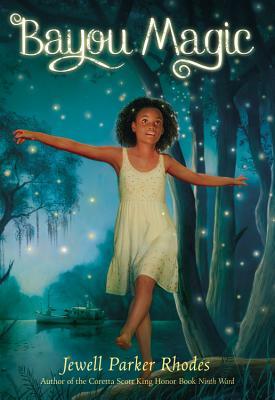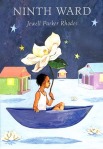 Carole Boston Weatherford is the vibrant author of some of the best children’s books exploring African-American history. I met Carole a year ago after she flew up from North Carolina to come visit our school library. As a snowstorm barreled in that day, we felt forced to change our schedule. Carole mastered the situation with grace and verve, adjusting each of her three sessions to relate perfectly to the age group. She recited poems to the youngest; she had children participating by chanting, jingling bells and tapping a triangle. They left the library joyous and inspired!
Carole Boston Weatherford is the vibrant author of some of the best children’s books exploring African-American history. I met Carole a year ago after she flew up from North Carolina to come visit our school library. As a snowstorm barreled in that day, we felt forced to change our schedule. Carole mastered the situation with grace and verve, adjusting each of her three sessions to relate perfectly to the age group. She recited poems to the youngest; she had children participating by chanting, jingling bells and tapping a triangle. They left the library joyous and inspired!

Image via Wikipedia
With the fourth and fifth-graders, she discussed Freedom on the Menu: The Greensboro Sit-Ins and presented a sensitive and nuanced look at Jim Crow as it still existed when she was a child in Baltimore. She showed a photograph of the park where she and her family were not allowed to go. The students were solemn and spellbound. Carole Boston Weatherford knows how to make history real to children.
Freedom on the Menu (Dial, 2004), is one my favorite read-alouds for Black History Month. Told from the point of view of eight-year-old Connie, the story takes readers to the Woolsworth’s lunch counter in Greensboro, NC. Connie and her mother often stop there for a soda after shopping downtown. Connie would like to sit down and have a banana split instead, but can’t; only whites may sit at the counter. “All over town signs told Mama and me where we could and couldn’t go,” Connie lamented. Lagarrigue’s somber, impressionistic paintings show the hateful Jim Crow signs that warp the community. Changes are in the air, though, as the Rev. Martin Luther King, Jr. comes to town. Connie sees her older siblings become politically involved and join in the lunch counter sit-ins. As the protests spread through the South, laws change. Six months later, Connie gets to savor her banana split at the counter, and it tastes like so sweet — like freedom. The author’s note about the 1960 Greensboro sit-ins provides additional information that will help young people understand the Civil Rights movement. See Weatherford’s web site for lesson plans inspired by this exemplary picture book, which works well with ages 6-10.
And don’t miss these treasures …
For older children:
The Beatitudes: From Slavery to Civil Rights. illus. by Tim Ladwig. Eerdmans, 2009. Ages 7-12. Anyone looking for a picture book to illustrate the role of religion in helping people survive and eventually overcome tragedy should take a look at this beautiful book. Weatherford illuminates the path from Jesus’ Sermon on the Mount to African-Americans’ long struggle for freedom and equality. From the dark Middle Passage in the bowels of slave ships to the inauguration of Pres. Barack Obama, people have found hope, strength, and inspiration in their religious faith. Concise biographical profiles of famous African-Americans are included.
Birmingham, 1963. Wordsong, 2007. Ages 10+  This stunning little masterpiece pairs actual black-and-white photographs with Weatherford’s poems to describe the ruthless bombing of the Sixteenth Street Baptist Church that killed four girls, an event that became a turning point in the struggle for equality. Told from the perspective on an unnamed fictional girl, we hear how
This stunning little masterpiece pairs actual black-and-white photographs with Weatherford’s poems to describe the ruthless bombing of the Sixteenth Street Baptist Church that killed four girls, an event that became a turning point in the struggle for equality. Told from the perspective on an unnamed fictional girl, we hear how
The day I turned ten
Our church was quiet. No meetings, no marches.
Mama left me in Sunday school
With a soft kiss and coins for the offering plate.
In addition to her moving poems, Weatherford provides a section that profiles the four young girls who died in the bombing. Additional historical background and photo citations are included, as well.
 Moses: When Harriet Tubman Led Her People to Freedom. illus. by Kadir Nelson. Jump at the Sun, 2006. Ages 7-12. This fictionalized story of Harriet Tubman focuses on the spiritual journey of the woman who risked her life time after time to help others escape from slavery, as she had done. In spare, poetic text, we hear how she flees Maryland, in hopes of reaching Pennsylvania. “A boatman rows her upriver. Back on shore, hounds snarl, sniff for Harriet’s trail. She races as fast as she can. Lord, I can’t outrun them. God speaks through a babbling brook: SHED YOUR SHOES, WADE IN THE WATER TO TRICK THE DOGS.” As Tubman encounters a series of dangers along the way, she calls upon God for help each time. When she reaches the free state of Pennsylvania, she finds her journey has just begun. Now it is time to help others. Nelson’s grand, atmospheric oil and watercolor paintings won a Caldecott Honor and the Coretta Scott King Award. Weatherford provides an accessible foreword on the institution of slavery, as well as an author’s note with a brief biography.
Moses: When Harriet Tubman Led Her People to Freedom. illus. by Kadir Nelson. Jump at the Sun, 2006. Ages 7-12. This fictionalized story of Harriet Tubman focuses on the spiritual journey of the woman who risked her life time after time to help others escape from slavery, as she had done. In spare, poetic text, we hear how she flees Maryland, in hopes of reaching Pennsylvania. “A boatman rows her upriver. Back on shore, hounds snarl, sniff for Harriet’s trail. She races as fast as she can. Lord, I can’t outrun them. God speaks through a babbling brook: SHED YOUR SHOES, WADE IN THE WATER TO TRICK THE DOGS.” As Tubman encounters a series of dangers along the way, she calls upon God for help each time. When she reaches the free state of Pennsylvania, she finds her journey has just begun. Now it is time to help others. Nelson’s grand, atmospheric oil and watercolor paintings won a Caldecott Honor and the Coretta Scott King Award. Weatherford provides an accessible foreword on the institution of slavery, as well as an author’s note with a brief biography.
For younger children …
Before John Was a Jazz Giant: A Song of John Coltrane.  illus. by Sean Qualls. Holt, 2008. Ages 5-7. Read it and then put on some Coltrane and dance!
illus. by Sean Qualls. Holt, 2008. Ages 5-7. Read it and then put on some Coltrane and dance!
First Pooch: Malia and Sasha Pick a Pet. illus. by Amy Bates. Marshall Cavendish, 2009. Ages 5-8. Light-hearted story of the First Family choosing their first dog.
Jazz Baby. illus. by Laura Freeman. Lee & Low, 2002. Ages 4-7. Rollicking, rhyming fun for little ones















